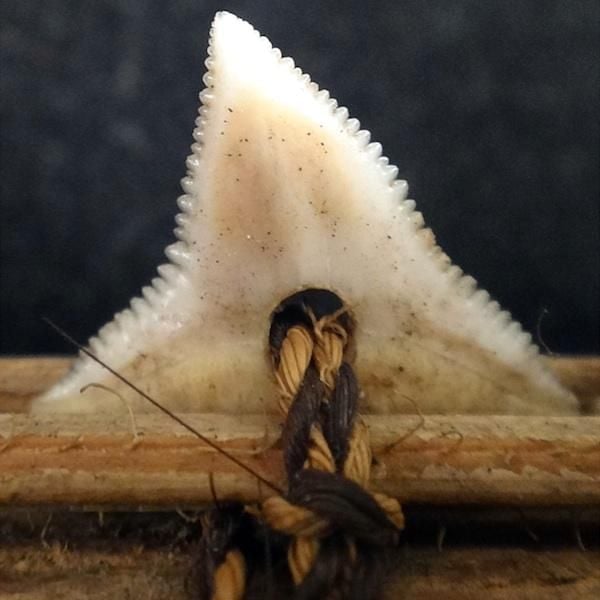19th Century Shark Tooth Weapons Reveal A Reef’s Missing Shark Species
Lashed to swords and spears from the Pacific’s Gilbert Islands are teeth from two shark species that were never known to have swam in the area
/https://tf-cmsv2-smithsonianmag-media.s3.amazonaws.com/filer/Surprising-Science-shark-tooth-631.jpg)
For decades, a total of 124 swords, tridents and spears taken from the Pacific Ocean’s Gilbert Islands in the mid-1800s sat untouched in vaults in Chicago’s Field Museum. The weapons—each made up of dozens of individual shark teeth that islanders lashed to a wooden core with coconut fibers—were primarily considered artifacts of anthropological value.
Then, Joshua Drew, a marine conservation biologist at the museum, had an unusual idea: that the shark teeth lining the serrated blades could also serve as an ecological snapshot of the reefs that lined the islands more than a century ago. Sharks can be clearly identified solely by their teeth, so the teeth that islanders had harvested and used for their weapons might reflect historical biodiversity in the reefs that’s since been lost due to environmental degradation.
When Drew and others closely examined the hundreds of teeth on the weapons, they found that they came from eight different shark species, six of which were known to commonly swim in the Gilbert Islands’ waters. Two species, though—the dusky shark (Carcharhinus obscurus) and the spottail shark (Carcharhinus sorrah)—were something of a surprise. When the researchers looked at the scientific literature and various museum holdings of fish collected in the area, they found that these two species had never been documented within thousands of miles of the islands.

Drew calls this “shadow biodiversity”—a reflection of the life that lived in an ecosystem before we even started studying what was there. “ hints and whispers of what these reefs used to be like,” he said in a press statement accompanying the paper documenting his team’s find, published today in PLOS ONE. “It’s our hope that by understanding how reefs used to look we’ll be able to come up with conservation strategies to return them to their former vivid splendor.”
Working with Mark Westneat, the museum’s curator of fishes, and Christopher Philipp, who manages the anthropology collections, Drew classified each tooth on every weapon by shark species, primarily using field guides and photos. In cases where the tooth’s identity was ambiguous, he made use of the Museum’s own ichthyological holdings, comparing it to preserved specimens from each shark species.
Because dusky and spottail shark teeth were found on the weapons—crafted sometime between the 1840s and 1860s, shortly before they were collected—the researchers believe these two species were once part of the ecosystem and have since been eradicated. There is the possibility that the teeth were harvested elsewhere and came to the Gilbert Islands via trade, but the team says it’s unlikely.
For one, sharks figure largely in the islanders’ traditional culture, and it’s well-known that they had effective shark-fishing techniques, making it unlikely that they’d go to the trouble of exporting teeth from afar. The two species’ teeth were among the most common found on the weapons, so it also stands to reason that they were fairly abundant nearby. Secondly, there is no historical or archaeological evidence that trade occurred between the extremely remote Gilbert Islands and either the Solomon Islands (the closest known location of spottail sharks) or Fiji (for dusky sharks).
It’s impossible to know for sure, but given the environmental degradation that’s occurred over the past century in the Pacific’s coral reefs, the researchers suspect that humans played a role in these sharks’ local eradication. Because sharks mature slowly and have a small number of offspring per individual, they can be wiped out quickly by moderate levels of fishing, and the commercial shark fishing industry started up in the area as early as 1910.
Rigorous fish surveys of the Pacific didn’t begin for a few more decades, so these weapons—and perhaps other human artifacts that incorporate biological specimens—serve as a valuable time capsule of the ecosystems that predated scientific study. Drew thinks that the “shadow diversity” we’ve since lost should inspire people in the marine conservation field to recreate the biodiversity that predates the Industrial Age.
“When we set up modern conservation plans, we shouldn’t sell ourselves short,” he told Nature last year, when he revealed his preliminary results at a conference. “We might not recapture the vivid splendor of those super-rich levels, but this information argues for setting up management plans to protect what sharks are there.”
/https://tf-cmsv2-smithsonianmag-media.s3.amazonaws.com/accounts/headshot/joseph-stromberg-240.jpg)
/https://tf-cmsv2-smithsonianmag-media.s3.amazonaws.com/accounts/headshot/joseph-stromberg-240.jpg)